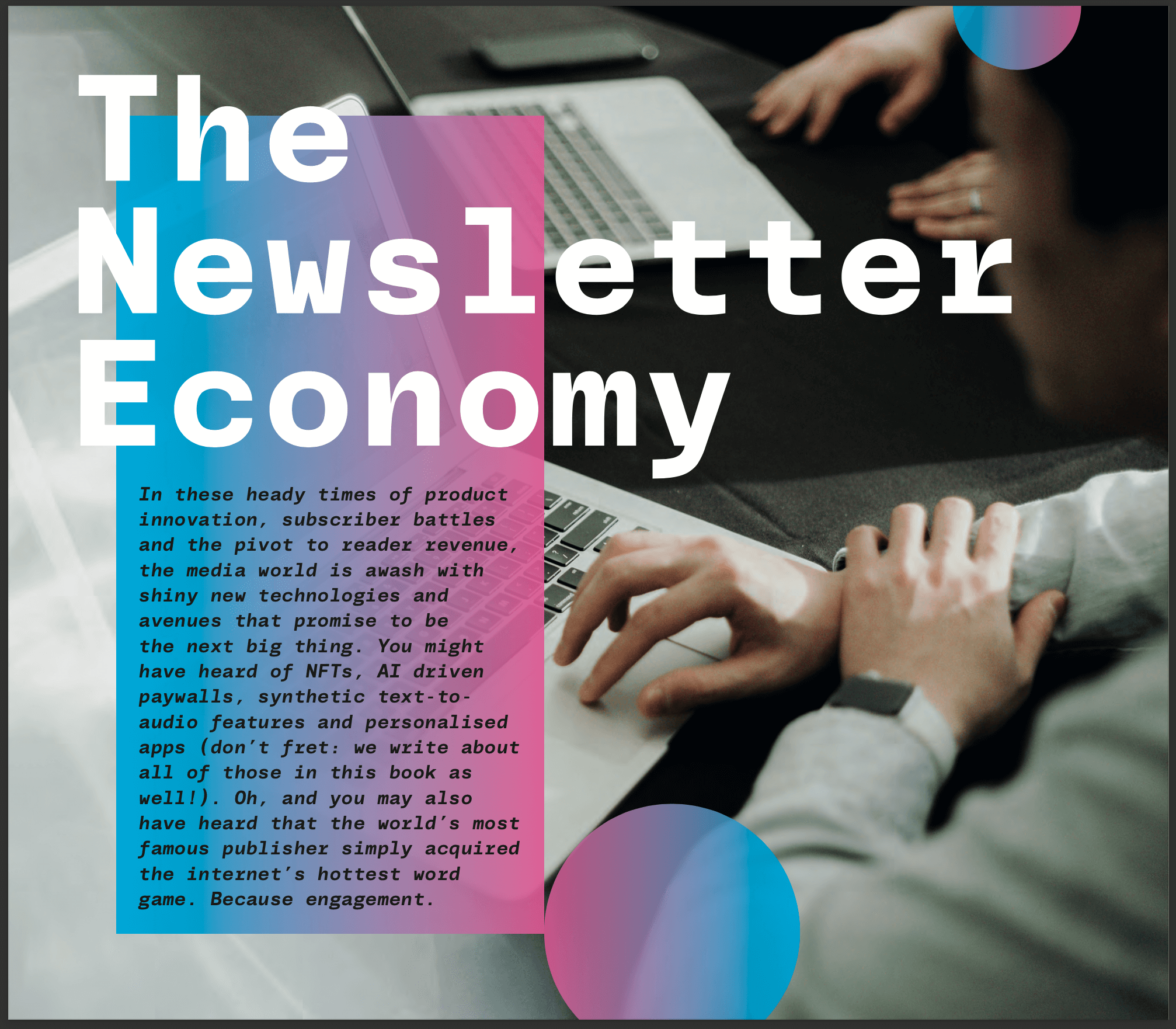
29 Jun The Newsletter Economy
The Innovation in Media World Report provides a comprehensive snapshot of the key technological paradigms that publishers need to navigate in order to keep their businesses relevant and thriving in the years ahead.
In these heady times of product innovation, subscriber battles and the pivot to reader revenue, the media world is awash with shiny new technologies and avenues that promise to be the next big thing. You might have heard of NFTs, AI driven paywalls, synthetic text-to-audio features and personalised apps (don’t fret: we write about all of those in this book as well!). Oh, and you may also have heard that the world’s most famous publisher simply acquired the internet’s hottest word game. Because engagement.

Welcome to the new newsletter economy. It’s the old medium that never quite went away, the publisher’s swiss army knife that keeps adding blades. “The great survivors” is how Sarah Ebner, head of newsletters at Financial Times, describes them, pointing out that they keep working because the reader has specifically signed up to read what you’re offering.
All the way back in 2014, the renowned media columnist David Carr mused that despite many predictions to the contrary, the death of the email newsletter was greatly exaggerated. “How can that be?” he asks. “With social media, mobile apps and dynamic websites that practically stalk the reader, how can something that sometimes gets caught in a spam filter really be taking off?”
Newsletters, Carr theorised, are clicking because readers have grown tired of the endless stream of information on the Internet, and having something finite and recognisable show up in your inbox can impose order on all that chaos. Subscribe if you want it, unsubscribe if you don’t. It’s a neat analysis that still holds good in 2022, though not even Carr, we suspect, could have foreseen what commentators described as “peak newsletter” – a time just before the pandemic hit in 2020.
“In the age of ceaseless content, everyone seems to have a TinyLetter or a Substack, and the personal-newsletter backlash is predictably here,” Claire Landsbaum wrote in Vanity Fair in July 2019. It might be a misguided backlash, she added, and so it proved during the pandemic when people were stuck at home and hungry for any and all kinds of information.

STACK UPON SUBSTACK It turned out that there was enough space for everyone to co-exist and newsletters actually became a huge driver of paid subscriptions, a trend propelled by Substack. Now five years old, the company that lets creators create, send, and charge for newsletter content came along at the perfect moment, the newsletter writer Dave Pell wrote in The Atlantic in November 2021. “The Trump years created a unique obsession with the media and raised the profile of countless journalists. Many of these journalists took their raised profile and left established publications to go direct-to-consumer with their writing. What we’re seeing is an indie news-delivery revolution,” Pell writes. “What we’re not seeing is a technological revolution. This movement is not about hiring 10,000 engineers to build a new version of human interaction.”
The combination of efficient business model and evergreen medium, allied to the pandemic-inspired thirst for content, brought Substack to a major milestone: 1 million paid subscribers in November 2021. It underscored people’s willingness to pay for quality content and despite the fact that they may have lost some of their star writers to Substack and other newsletter platforms, publishers were optimistic that the portends were good for their own subscription efforts.
“I would regard anything that is about helping make the market for paid digital journalism as good,” New York Times CEO Meredith Kopit Levien told investors in the same month. “This is still a forming market. And I would regard all efforts to get more people to think about paying for high quality journalism is a positive thing.”
Sure enough, the American news site Axios was soon reporting that the Substack threat to newsrooms was overblown and the bigger publishers were hitting back, embracing the idea of the independent-operator model. “Pressure from new publishing platforms has finally pushed newsrooms to create programs that give writers more pay, autonomy and flexibility, Axios’ media reporter Sarah Fischer noted. And those changes were bringing some prominent independent writers back to traditional news companies.
More superb reporting from Fischer followed on the creator economy as a whole, which was supposed to democratise media, but it turned out that a small portion of creators still reap the most revenue for their work across multiple platforms. One figure that stood out in particular for newsletters – Fischer reported that the the top ten publications on Substack collectively make more than $20 million a year in subscription revenue, while less popular newsletters typically make tens of thousands annually.
THE NEW FRONTIER Not that long ago, being relegated to a newsletter was considered a journalistic demotion, Jack Shafer writes in Politico. It was Substack that arguably changed this irrevocably, to a time when writing a newsletter has become something of a prestige beat for writers. For publishers of course, as Shafer notes, the business imperative is huge. “The newsletter form offers publishers something advertisers crave: a targeted audience. When you subscribe to a newsletter, you reveal that part of your identity defined by your interests and that has value. Advertisers would rather reach the right 50,000 readers than 5,000,000 randos, and they especially covet audiences to whom they can repeatedly serve targeted content”, Shafer notes. “Instead of letting all those precious eyeballs disappear into the Substack writers’ room, publishers have found that they can provide plenty of room for newsletter writers to roam.”
For the star writer or the lesser light, for the legacy newsroom or the digital upstart, this is now the new golden age of newsletters, and the numbers show it. “There are so many ways technology has helped email newsletters become a replacement for the newspaper and magazine as people’s view into the world and how they get news and information,” Kerel Cooper, CMO of email service provider LiveIntent, told Digital Content Next. LiveIntent’s Industry Pulse Survey of 200 senior marketing and publishing executives showed 87% of publishers and marketers actively investing in email and 94% scaling their email programs in 2021, a trend that is set only to grow this year.
Now that we’ve surveyed the frontier, let’s set out the new rules of engagement. What strategy should you follow, who is getting things right and which are the companies making the big moves? Here’s our comprehensive rundown:
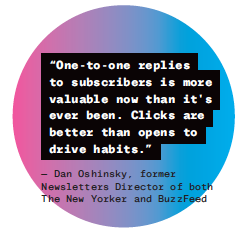
METRICS – BEYOND OPENS Here’s Dan Oshinsky, former Newsletters Director of both The New Yorker and BuzzFeed, talking about newsletter metrics in an interview with The Fix in 2020.
“First of all, no organisation sees 100% of readers open their emails. If you can get 30% of your readers to open your newsletter, that is very good. A 25% click to open – meaning 25% of readers who open a newsletter click on something – that’s really, really good.” The other number Oshinsky shared is that the best newsrooms convert about 10% of unique visitors to newsletter subscribers.
The open rate was formerly the standard by which to measure the success of a newsletter. But by 2021, Oshinsky and others were warning that publishers needed to start looking at other measures and do more to engage with readers of their newsletters. Central to this is data privacy policies being instituted across the board by Big Tech companies and in this case, Oshinsky is referring in particular to Apple releasing mail privacy protection in the fall of 2021, a new feature that “helps users prevent senders from knowing when they open an email, and masks their IP address so it can’t be linked to other online activity or used to determine their location.”
The result, Oshinskt told an International News Media Association (INMA) conference in July 2021, would be that media companies may start to see differences in their metrics since Apple was essentially opening up people’s emails behind the scenes before it hit a user’s inbox. Remember that Apple Mail is the dominant email platform in the U.S. and elsewhere. As a result of this change, Oshinsky says companies may start to see inflated open rates and find that location data isn’t accurate.
To battle back, he recommends that newsrooms focus on progressive profiling and ask questions to gather information on readers: “What are they interested in? Where do they live? What do they do? What do they want more of? We can start to personalise the user journey and the specific newsletters to serve these audiences.”
News media companies, he says, should measure success by engagement. “One-to-one replies to subscribers is more valuable now than it’s ever been. Clicks are better than opens to drive habits and use user-submitted data more to personalise the experience as best we can.”
“What percentage of our audience has actually filled out this info, given us this info? What percentage has given us location data? Do we know their job? Do we know what they’re interested in?”
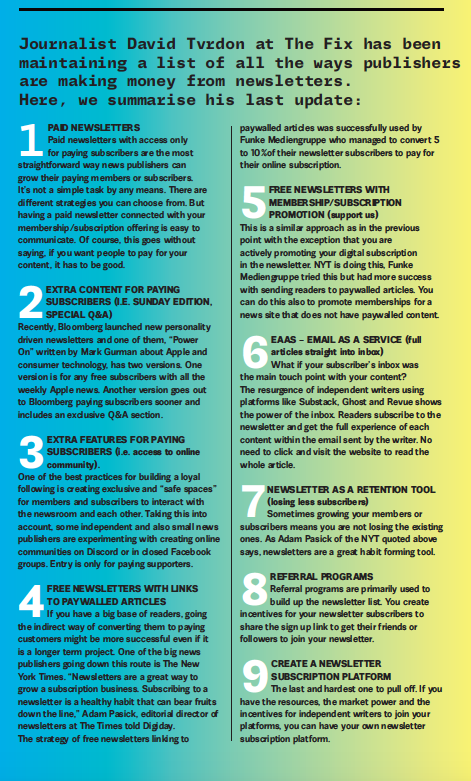
As an example, Oshinsky mentioned the female-focused Canadian sports site The Gist, which asks its readers where they are located when they sign up for its newsletters. “Based on that information, they personalise certain sections of the newsletter,” Oshinsky said. So readers in New York may get more basketball and baseball news and readers in Toronto may see more about hockey.
One company that’s ahead of the curve on this development — no surprises here — is the Financial Times. The FT’s Sarah Ebner, who we quoted earlier, says the company uses several different metrics to measure success, realising that even numbers like click-through rates, though more informative than open rates, are not enough.
“Even to the extent of someone’s opened a newsletter, are they really reading it all the way through? You don’t know that,” Ebner, who was also a speaker at the INMA conference, said. The FT likes to engage its readers intimately, asking them to fill out newsletters with specific questions, polls, and user surveys. “People like that one-to-one relationship,” Ebner says. The company then looks at time spent on their site from a newsletter click to gauge its success.
One piece of advice Ebner has is not to be afraid to A/B test. The FT saw a 5% increase in openings when it changed the sender from the name of the publication to the first and last name of the writer.
This interactive feature in newsletters was also highlighted by Funke Mediengruppe, one of the largest German multimedia companies with 13 regional daily titles, whose digital growth was spurred by an extraordinary five-fold increase in newsletter subscribers over 2020. The German publisher is often cited as a case study for rapid digital transformation.
Nadine Lange, who has managed the Digital Transformation Project at the company since 2019, pointed out audiences respond well to tests and surveys. “These elements also serve as additional measuring tools for audience engagement research,” she saidbin an interview with The Fix.
More broadly, what we are arriving at is an increasing sophistication with which successful publishers approach the unique data that can be generated by newsletter readers, honing in on the granular specifics.
“Look at the content consumed most by loyal users as that is a guide to what your newsletters should be based around,” advises Martin Little, audience transformation director of the UK publisher Reach. Newsletters are now a key way to get users to come back to one of the publisher’s more than 80 online brands.
Little continues: “Build up your mailing list. Focus really hard on your mailing list and make sure it’s quality as well. It’s not a case of buying users or a mailing list because their engagement levels will be low, you need to use your website’s inventory well. Again target loyal users – where are they visiting on your site? What sections? What pages? Optimise the inventory on your pages to get those people to sign up.”
Oshinsky refers to this practice at the INMA conference, wanting to see companies to personalise the experience for readers and then lead them toward more content as they move along. “You become a subscriber. Great. After you register and subscribe, we’re going to encourage you to sign up for different types of newsletters,” he says. The one key learning here is this” at this current moment newsletters are almost unparalleled both in generating audience insights and the potential they harbour to make inroads into niche segments and interests.
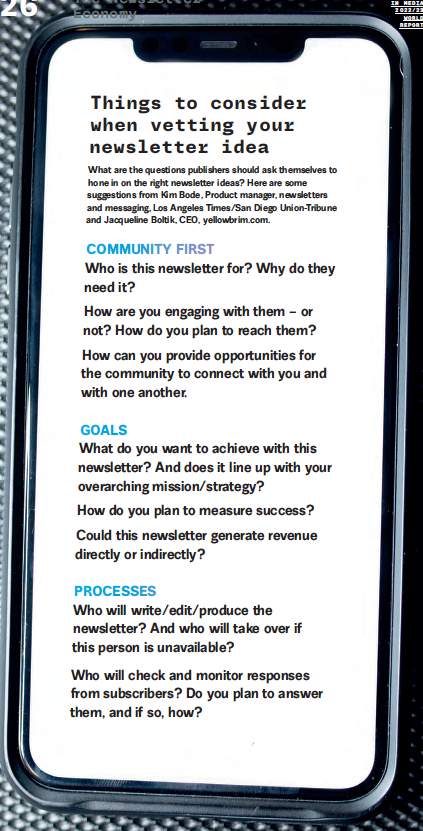
EXPERIMENT, AND THEN REFINE In October 2021, Digiday reported that British publisher The Telegraph was betting that offering fewer, more focued newsletters would actually help grow the number of subscribers to them. The publisher used engagement rates, among other factors, to inform sunsetting about a half dozen newsletters and consolidating others due to “underperformance,” Dan Silver, The Telegraph’s director of email and newsroom innovation, was quoted as saying.
Here again is one of the key questions that publishers have to address in this age of ever-continuing peak newsletter. Do you forge ahead with more variety, targeting the various niches that present themselves from sophisticated audience research, or hone in on the most successful? The Telegraph’s experiment represents a fluid approach that would work well for the future.
“Newsletters can have a shelf life. It’s fine to unsubscribe to one newsletter and sign up for another newsletter. We have a very fluid at titude to these editorial properties,” Silver said. This is because, Little explains, “Newsletters are easy to get out, on the ground, and test new concepts.”
The Telegraph tracked newsletter readers’ habits and found overlaps among audiences and topics, such as Letter from the USA and Letter from the Middle East — foreign dispatch newsletters — that were combined into one global newsletter called The Dispatches. Elsewhere, three rugby newsletters were condensed into one. The Telegraph still has a significant number of newsletters sent out by editorial teams — more than 40 according to Digiday, eight of which are exclusive to paid subscribers. That number should give you an idea of the scale at which bigger publishers are allocating resources to newsletter strategy, with the British media trade magazine Press Gazette reporting, by way of comparison, that the The New York Times, Washington Post and The Guardian all send out over 50 newsletters on a range of subjects.
Peak newsletter right? Well, it’s also a perfect illustration of just how agile the medium can be, with publishers identifying niche areas for coverage as well as adapting content and storytelling to major news events. Not surprisingly, 2020 was the heyday of the pop-up newsletter. The Washington Post for example, in the span of just two months, saw its coronavirus newsletter become by far the most popular of the more than 70 newsletters it offers. The New York Times similarly reported that Its newsletters around big news events, including the “Coronavirus Briefing,” “Coronavirus Schools Briefing,” and “At Home” had over 180 million opens.
Experimenting with pop-up newsletters was also central to the strategy of Funke Mediengruppe whose success with dramatically increasing its number of newsletter subscribers we referred to earlier. Funke created pop-up newsletters, which are used for trending topics. Then they’d kill that newsletter when the event was over. However, in some cases they would adapt the product depending on the response and the purpose it might serve in the future. They would not kill the pop-up before they had something else to offer them. “We did pop-up newsletters for the U.S. election last year,” Funke’s Lange told INMA. “We moved them to permanent ones so there’s a U.S. politics newsletter now for general readers.”
Funke also saw great retention with its once-a-week newsletter that only talks about good news, a strategy that several publishers adopted in tandem with focus coverage about Covid and other news stories. The Telegraph experimented with a newsletter promising a pandemic-free reading experience called In Other News, while the Guardian took a more data-driven approach with The Antidote, a daily listing of the most popular non-coronavirus stories.

IDENTIFY NICHES, THEN DEPLOY Here’s the thing about Funke Mediengruppe’s newsletter transformation that we haven’t told you so far. The publisher’s strategy centred around 12 main daily newsletters and 75 others covering a specific topic. That sounds like an enormous project right? Well, it was launched by a group of five people! And they were responsible for the following: editorial, marketing, tech, product and project management, and digital transformation management.
And here’s the lesson here: with the right organisation you can launch your big flagship newsletters, devote resources to understanding your audience, and aggressively going after specific target segments. We’ve spoken so far about some of the bigger names, skewing somewhat toward the U.S., but a new report published by the World Association of News Publishers (WAN-IFRA) in January 2022 looks into how 10 European newspapers adopted an audience-centric mindset during the Table Stakes Europe programme, conceived primarily (but not only) for local and regional news organisations to help drive digital growth by refocusing on audiences. Needless to say, newsletters were key to helping these publishers serve their audiences with targeted content, and helping to transform casual readers into loyal subscribers. Here are some examples, summarised by journalist Faizal Kalim for What’s New in Publishing.
The German publisher General-Anzeiger launched a weekly newsletter called Bonn Appetit aimed at foodies that had more than 600 people signed up even before the first issue was published in late May 2021. The decision to launch a food-related newsletter was driven by editorial instinct which was backed by data, according to Sylvia Binner, Head of Editorial Development for General-Anzeiger. “At first, we trusted our gut feeling,” she says. “Then we analysed the data. We saw that – depending on the method used [Personas and Google Interest categories] – we have between 560,000 and 750,000 foodies in the region. That’s when the decision was made.” The publisher now plans to build upon the success of Bonn Appetit with a podcast, video show, and live events like wine tastings and cooking classes.
Similarly, the Spanish publisher Diario de Navarra decided to launch a range of products in the family segment. The paper launched a dedicated newsletter in 2019 and also organised live events like the Expo Family Fair, round tables and book presentations. Recently, Diario de Navarra narrowed its audience focus from families in general to parents who have children enrolled in compulsory education.
The publisher also has a newsletter that caters specifically to professionals, defined as the segment of people who hold middle and upper management positions, as well as self-employed workers like lawyers and doctors. This group makes up 18,000 people in Navarra and the newsletter had 3,600 subscribers in late 2021, having increased its unique readers by over 24% in recent months.
Nordwest-Zeitung is another German publisher with a family-focused newsletter called “Familienzeit” (Family Time) that has 3,000 subscribers and also drives digital subscriptions. The newsletter which focuses on service, excursions, and cooking tips was developed after surveying readers on what they would like to see in the product.
Circling back now across the pond, in May 2021 Adweek reported on the newsletter portfolio expansion of the technology website The Information. Take a look at the topics they were planning:
“Four times a week, reporter Matthew Olson will write Reality Check, which covers the worlds of augmented and virtual reality. Reporter Yunan Zhang will publish the Mandarin and English-language China newsletter every other week, covering the latest developments in the Chinese tech industry,” Mark Stenber reported for Adweek.
Another newsletter, still a work-in-progress at the time, would build upon The Information’s proprietary organisational charts, tracking the comings and goings of key executives to map the taxonomies of power within influential tech companies. Further newsletters were planned to cover the creator economy, the cloud enterprise space and the world of cryptocurrency.
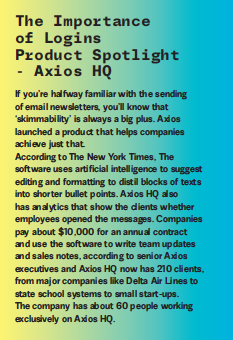
Does this sound niche in the extreme? “My hope is that people say, ‘Oh man, no one’s gonna read that.’ And then a couple of months later, we’ve got hundreds of thousands of people reading it,” the site’s founder Jessica Lessin told Adweek. “That’s what we’re going for.” Adding in-depth, niche resources to its subscribers helps The Information reduce churn. By giving them more for their money, the publication hopes to keep readers subscribed for longer, an effort Lessin calls “super-serving” its readers.
“What we are seeing across the board is that consumption is shifting from generic to specific, Reuters Institute Professor and digital transformation expert Lucy Kueng said in an episode of the Media Voices podcast. “There’s various prime real estate in terms of very interesting areas that really have traction with audiences that advertisers are interested in, that are being plucked off by players who are doing either newsletters or podcasts, or both, who are very dangerous to mass media players because they offer both speed and depth.”
A great example to highlight here is the business-centric newsletter publisher Industry Dive. In February 2022 Adweek again reported that the publisher is on pace to generate between $105 and $110 million in revenue for the year, and it is testament “to the value of stitching together pockets of niche readership into a sustainable audience.”
Industry Dive has a network of 53 business-centric newsletters serving 22 different industries. It reaches 2.5 million free subscribers through a mix of 25 daily and 28 weekly email products, and caters to business professionals across fields including construction, waste management, retail and biopharmaceuticals, but the branding and design of the newsletters are uniform. Industry Dive launches new email products in at least two industries per year. Launched in 2012, the publisher is just 10 years old, and has been profitable since 2014.
LEAN INTO PERSONALITY Here’s an announcement from The New York Times in April 2020: “Quietly, our flagship email newsletter, The Morning Briefing, has become one of our biggest and most important news products. The newsletter now has more than 17 million subscribers, one of the largest daily audiences of any kind in journalism, across television, radio, print and digital.
“That’s why we are turning to one of our most authoritative and nimble journalists to take the helm. We are thrilled to announce that David Leonhardt will return to the newsroom to become the new writer, host and anchor of our flagship newsletter, which will be rebranded as The Morning.”
A host and anchor for a newsletter? That’s the kind of star power talk most obviously associated with television. And it’s the clear example of how the success of the Substack ecosystem has affected and filtered into traditional newsrooms.
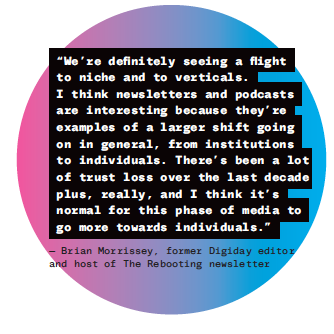
“We’re definitely seeing a flight to niche and to verticals. I think newsletters and podcasts are interesting because they’re examples of a larger shift going on in general, from institutions to individuals. There’s been a lot of trust loss over the last decade plus, really, and I think it’s normal for this phase of media to go more towards individuals,” Brian Morrissey, former Digiday editor and host of The Rebooting newsletter told the Media Voices podcast.
Let’s look at two recent examples. In September last year, Axios reported that The Washington Post was relaunching its 202 newsletter suite with new emails, new authors and an expanded product suite. Key to the rebranding was that the new products were meant to be more personality driven, according to Rachel Van Dongen, editor of The Post’s 202 newsletters. “We’re leaning into personalities. In these newsletters specifically and around town, people want to connect with the authors and have two-way communication,” she says.
Then, in March 2022, Digiday reported that The New Yorker has switched up the presentation of its daily newsletter, rolling out a “voicier and more editorialized approach for readers’ inboxes.” The idea was to infuse a bit more personality and original content.
TAKE THE MOMENTUM AND BUILD YOUR OWN NEWSLETTER NETWORKS If a rebrand sounds too low-key, why not go all the way and launch your own personality-driven content network? In November last year, U.S. publisher The Atlantic came up with a plan to basically import independent writers already in the paid newsletter business. While letting them stay independent the publication planned to get these writers behind The Atlantic’s paywall and convert their subscribers to Atlantic subscribers them stay independent the publication planned to get these writers behind The Atlantic’s paywall and convert their subscribers to Atlantic subscribers.
One notable recruit for this programme was Charlie Warzel, who left The New York Times to set up shop on Substack with the technology newsletter Galaxy Brain. In a post candidly explaining why he was leaving Substack to go back to the traditional media fold, Warzel explained that in his reckoning, he was worth more to a publication as part of a package of writers/reporters/thinkers than he was on his own. “This makes sense to me. I don’t break tons of news these days and my work lately has been either explanatory or analytical. That may be a harder thing for somebody to pay for individually, but as a larger stable of people, I might fit more nicely into a bundle.”
Vox reported more details on The Atlantic’s plan. The publication isn’t hiring the writers as full-time employees, but will offer them some sort of base payment with the ability to make additional money if they hit certain subscriber goals. Newsletter writers who join the Atlantic’s program get to keep their existing list of subscribers so they can start up their businesses again if they decide to leave. Plus, in addition to their newsletter, their subscribers get access to any other newsletters the Atlantic publishes and a year’s subscription to The Atlantic itself, which currently sells for $50 a year. They will remain largely editorial independent but may get some “light editing” from The Atlantic’s editors.
Late last year, Axios reported that The Information was in the early stages of launching “The Information Newsletter Network,” a platform to power independent newsletter writers on The Information’s tech stack. The company’s first member, per Axios, is the newsletter Parqor from Andrew Rosen. Rosen’s newsletter was previously on Substack. CEO Jessica Lessin says the first batch of newsletters are business-related, “but our lens for inviting writers to participate is really just whether we love their content.” The platform, she added, is “designed for subscription newsletters and the vast majority will be paid, but one of the next to launch is currently free and exploring paid related products.”
Earlier in the year, Forbes also announced that it was launching a newsletter platform that would allow journalists to launch their own paid newsletters and split the revenue with the publisher. To set the new “Journalist Entrepreneurs” program up for success, Forbes planned to hire 20 to 30 writers with large audiences, according to Subscription Insider. These writers and journalists will get the benefits of being part of the Forbes ecosystem, 103-year-old publisher, including marketing, editorial and financial benefits. At the same time, the writers would enjoy editorial freedom to keep their readers interested.
Sounding familiar by now? In terms of financial benefits, Subscription Insider reports that writers will share subscription newsletter revenue in a 50/50 split with Forbes. The publisher will also share a portion of advertising revenue with writers, based on page views and a bonus for returning visitors.
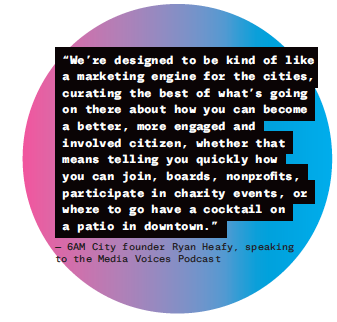
USE NEWSLETTERS TO CONVERT MORE PAID SUBSCRIPTIONS We’ve been flirting for a while now with the serious business end of things when it comes to newsletters. We come now to the meat of it – how effective can newsletters be at driving subscriptions at scale? And looking ahead even, can entire business models be built around email offerings?
In August 2021, The New York Times said that it would make a slate of newsletters available only to subscribers, including new offerings from John McWhorter, Kara Swisher and other writers. The publication had lost a few writers to Substack over the years and its response had been months in the planning.
“The Times, which has produced free newsletters for 20 years, now has about 50 newsletters, which are read by 15 million people each week, the paper reported. Eleven of those will become subscriber-only, along with seven new newsletters, Alex Hardiman, The Times’s chief product officer said.
Speaking to Niemen Lab, Hardiman described introducing subscriber-only newsletters as “both a retention play and a conversion play.”
“When we look at the intersection between our subscription model and newsletters, newsletters are already really important,” she said. “We see that almost half of subscribers open a newsletter in a given week, and people who do receive newsletters are far more likely to pay and to stay.”
You can see the appeal of a model like this for The Times, which in February this year surpassed 10 million subscriptions. However, that number is still a fraction of the 100 million people who have registered with their email at nytimes.com. The move to double down on subscriptions, according to Nieman Lab, is a bid to boost the value of a Times subscription, and maybe nudge some of those free newsletter readers into paying for a subscription. “This is only the start,” Opinion editor Kingsbury told Axios of the move at the time. “We are still talking to writers across a bunch of different topics.”
How did the Times choose which newsletters to put behind a paywall? Hardiman outlined three broad categories of emails to Niemen lab — briefings, personalised alerts, and (now) subscriber-only newsletters — and said that each type plays a different role in subscriber strategy.
Briefings like The Morning from David Leonhardt, he said, will stay free because they are so effective at promoting discovery – at pointing readers to news articles as well as podcasts, puzzles, and other content. The second functions as personalised alerts to help readers follow their favourite writer or stay on top of issues they already care about. The ones behind a paywall then fill a distinct user need.
“The subscriber-only newsletters offer exclusive journalism from experts who go deep on the topics that our subscribers are most passionate about, and do it within the convenience of the inbox,” Hardiman said.
In a similar vein, online business news publisher Quartz shook up its membership offering last year by creating four premium emails. Digiday reports that according to a March 2021 survey, 75% of Quartz’s members said they were primarily accessing Quartz’s content through email, according to Quartz editor-in-chief Katherine Bell, explaining in large part why the publisher chose to expand in this area.
Since it launched in 2018, Quartz’s paid subscription programme – or membership – included two emails: How To, which brings practical tips around being more effective at work, investing, or general life advice; and The Weekend Brief, which is a wider lens on the most important news story of the week. Journalism.co.uk reported that two new emails were added to the list: The Forecast, which provides a short, sharp look forward at an emerging industry, technology, or trend; and The Company, spotlighting companies that are changing (or are about to change) the way their businesses work.
BUILD AN ENTIRE BUSINESS MODEL AROUND NEWSLETTERS Around 1,800 US newspapers closed between 2004 and 2019, according to research published by Northwestern University’s Medill School of Journalism. As with all things in media, the Covid-19 years acted as an accelerator, with more than 10 local newsrooms closing according to an estimate by Poynter. These newsrooms, they write, are often more than 100 years old, and often the only news source in those places.
Over the past year, an idea for a new business model has swept through the local news landscape in the U.S and it is powered by two companies who believe they have found the formula to reverse this decline. You’ll be unsurprised to hear that the idea is newsletters. But it might still be a stretch to wrap your head around the idea that for an ambitious digital news company, email is not a supporting revenue or engagement stream. It is the main product.
Between them, the two companies, Axios Local and 6AM City have launched 42 local newsletters, covering cities across more than 20 states. By the summer, according to reporting by Press Gazette, that number will have grown to at least 49.
And both companies believe that their business models can be successfully rolled out to 100 cities or more. Both say they generated around $5m in revenue in 2021. Axios predicts that it will triple that number in 2022, while this March, 6AM reached 1 million newsletter subscribers and also say they are on track to cross $10 million dollars in revenue.
Axios and 6AM are perhaps the biggest but they are by no means the only players in the local news newsletter scene. Other companies like WhereBy.Us in the U.S. and Overstory in Canada have rushed to build local newsletter networks and have similarly ambitious expansion plans. Platforms like Substack and Tiny News Collective meanwhile, have given out grants to support local news writers create newsletters. These are not just cash handouts but programmes with a strong focus on acquiring subscribers and building sustainable revenue.
“Fueling this local news gold rush is a shared hypothesis,” Mark Stenberg writes for Adweek. “By treating email as the primary product, a small team of locally based journalists can grow a financially stable news operation with little overhead.”
Let’s take a look at how they work. Stenberg reports that in each outpost, Axios Local hires two reporters who work in tandem to produce a daily newsletter. Most newsletters feature six content sections, called “cards,” and at least one piece of original reporting. The journalists curate reporting from other local news affiliates, striving for a mix of long- and short-form material.
The bulk of revenue is generated through newsletter sponsorships, which keeps its email product free. Unlike Axios proper though, the Local program places a greater emphasis on featuring regional advertisers and hopes to split its advertising 50-50 between local and national partners. In October last year Axios launched a membership programme for the Local programme. Suggested contributions, listed on new city-specific sites, range from $50 to $500 per year.
6AM operates with a very different content strategy, actively choosing to avoid covering crime and politics to create a “safer place for both the reader and the advertiser”, according to Press Gazette. The business model is currently driven by advertising, with the breakdown about 70% local and 30% regional according to Adweek.
“The publishing industry has seen its grip on the digital ad market weaken over the last decade, but as newsletter appetite has grown, newsletter advertising has remained a bright spot,” Stenberg notes.
It’s not just local news that can place email at the heart of a business model. Former Vanity Fair editor Graydon Carter launched Air Mail in 2019 as a weekly subscription newsletter for high brow individuals. It covered topics.
Air Mail launched with a focus on covering stories that cater to an influential news consumer across topics like arts, politics, culture, literature, film and television and fashion, its content accompanied by glossy, print-like magazine ads from premier brands. The sort that you might expect to find in Carter’s old publication Vanity Fair, a reflection of Carter’s days at Vanity Fair. The company has several other newsletters and has recently expanded out into podcasts and e-commerce. Its premier Sunday email though, costing about $80 per year, is the major breadwinner.
BE WARY OF WHAT COMES NEXT Where there’s a successful business model to eat into and potentially co-opt, you can bet that Big Tech would have caught the scent. Google, Twitter and Face-, sorry, Meta have all announced their intentions to get into the newsletter game last year and those plans should pick up pace in 2022.
Meta plans to “support independent writers” by creating a free, self-publishing tool to create individual websites and an email newsletter. In addition, the company said it planned to help writers find audiences and sell subscriptions. Google meanwhile, has a project in the works called Museletter which allows anyone to publish a Google Drive file as a blog or newsletter to their Museletter public profile or to an email list.
The effort, TechCrunch reported, would essentially repurpose Google’s existing document-creation tools as a means of competing with other newsletter platforms like Substack, Ghost or Revue.
The last of those was acquired by Twitter. In August last year the company started testing a feature that brings Revue newsletters more prominently into the Twitter experience, according to another TechCrunch report. Users will be able to see writers’ Revue newsletters appear on their profile beneath their follower counts. If you click subscribe, you’ll be prompted to read a sample issue or subscribe using the email address connected to your Twitter account. This is a strategy that may prove to be the most successful yet among the Big Tech plays.
There is reason then, to keep a watchful eye, but not to fear. Remember that it is writers and publishers who powered the success of this new medium, finding a way to connect directly with readers and bypassing any algorithm that Big Tech could throw into the mix. That connection with audiences will drive the future business of newsletters, and perhaps of media as a whole. Long may it continue! l


